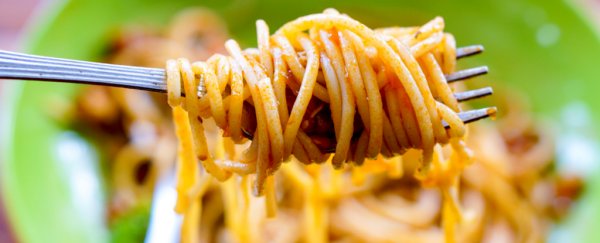If you've gone for seconds, or even thirds, on your housemate's rather average homemade pasta, there's a chance your taste for starch might have more to do with your freaky tastebuds than their culinary skills.
Following up on earlier discoveries of an additional gustatory sense specific to complex carbohydrates, researchers have now found some of us more sensitive to the taste than others, which could be helping to fill out some of our waistlines.
Scientists are now pretty certain our tastebuds can actually detect the long chains of sugar making up the complex starches found in food items such as bread, pasta, and rice.
So even though we still only have five 'official' tastes, we can actually list the sensations caused by chemicals dissolving in our mouth as sweet, salty, umami (savoury, meaty flavours), bitter, fat, sour, and… starchy.
While we're on the subject, forget that tongue map nonsense you might have learned as a kid, too. Even though most of us might be able to detect bitter flavours better down the throat, our entire tongue reacts to all of these sensations.
That said, taste sensitivity varies significantly across the population.
So-called 'supertasters' experience far more intense flavour sensations. And a little more than a quarter of us – depending on our genetic background – can't even taste a compound called phenylthiourea.
Since our individual tasting talents vary, researchers from Deakin University in Australia were keen to put the discovery about starchy tastes to the population test.
A group of 34 adults had their bodies measured and diets detailed before and after they participated in a number of tasting sessions.
Each subject was given solutions of a starch called maltodextrin and the soluble fibre oligofructose in different concentrations - to determine their range of sensitivities.
Adding up the numbers, it was clear some volunteers were better at spotting whether they were sipping starch or fibre at low concentrations.
On analysing the data, those who were more starch-sensitive weren't found to be bigger than the rest, having roughly the same body mass indexes.
But their diets were higher in calories. And there was one other significant difference.
"We specifically looked at waist measurements, as they are a good measure of the risk of dietary related diseases," researcher Julia Low from Deakin University said in a press statement.
"Those who were most sensitive to the carbohydrate taste ate more of these foods and had a larger waist."
While numerous factors determine how fat builds up around our bellies, the study's results suggest an ability to taste – and presumably enjoy – sugars in the form of starch make it that little bit harder for some to lose the spare tyre.
Excess amounts of abdominal fat is largely considered 'the worst of the worst' when it comes to weight gain, especially where our heart is concerned.
"Increased energy intake, in particular greater intakes of energy-dense foods, is thought to be one of the major contributors to the global rise of overweight and obesity, and carbohydrates represent a major source of energy in our diet," says the study's lead researcher Russell Keast.
Two years ago, Keast and his team conducted research that added fat to the list of things we can directly taste.
It was found that the people who were more sensitive to fat consumed less fatty foods – the complete opposite for carbohydrates.
"What that could mean is that individuals who are more sensitive to the 'taste' of carbohydrate also have some form of subconscious accelerator that increases carbohydrate or starchy food consumption," says Keast.
"But we need to do much more research to identify the reason why."
Given how many new units of flavour have been discovered in the recent years, we bet this is not the last we'll be hearing about advances in tastebud science - and how the tongue can actually influence our diet.
This research was published in The Journal of Nutrition.
